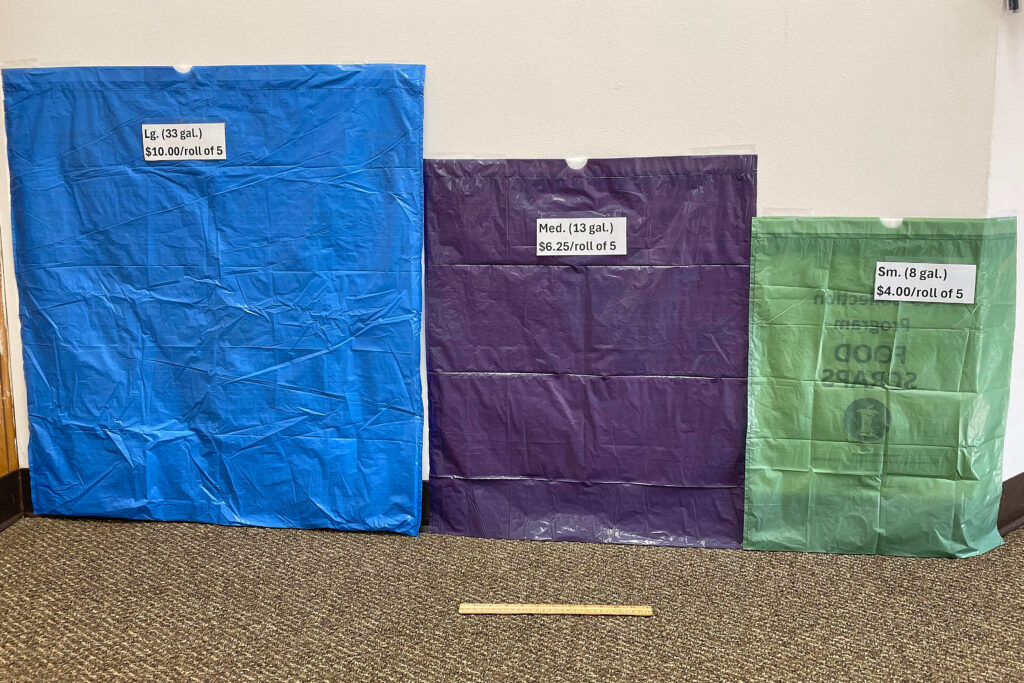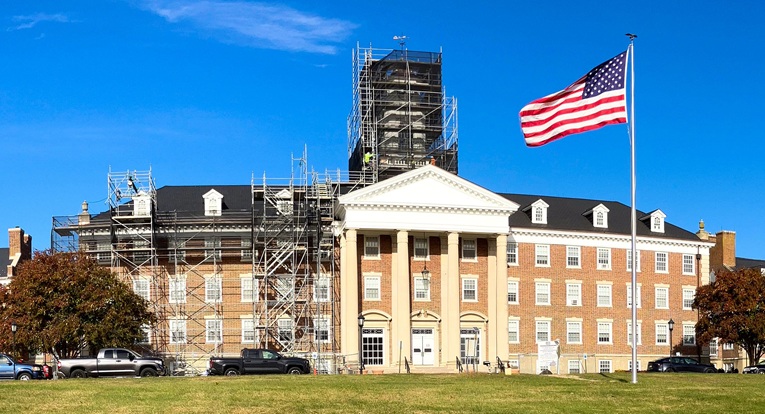This article addresses Greenbelters’ practical questions about the Save As You Throw (SAYT, “say it”) trash program, for which a yearlong pilot begins January 1, 2026, for residents who use the city trash service. Watch greenbeltmd.gov/sayt and check page 5 of the News Review for updates.
Why?
City Council adopted the mandatory pilot to incentivize all households with city trash service to reduce their trash and align costs with usage (see articles in the May 15, September 18 and October 9 issues). The alternative was raising everyone’s annual fee from the current $280 to around $400, regardless of their trash quantity, says Sustainability Coordinator Luisa Robles. The goal according to Robles is to encourage homeowners to reduce their trash and costs through decreasing and diverting waste to recycling, composting and donations and thus reduce landfill fees and use, truck and fuel use, trash crew effort and greenhouse gases. The city has a goal of reducing trash citywide by 44 percent.
Some residents have complained that the new system will not save them money. Our review suggests even those with one small, eight-gallon bag of trash a week will pay slightly more. The “save” element in the pilot program is not a saving on 2025 trash costs but on what a standard increase would be without this option.
Why January?
The GHI Board asked the city to begin in January to avoid changing Greenbelt Homes, Inc. (GHI) co-op fees mid-year during the GHI January-December fiscal year.
How Will It Work?
All households will pay a flat annual base fee. They will also pay variable costs for landfill fees according to how much trash they produce, choosing either 1) buying and using as many SAYT bags as desired or 2) buying a Max Trash sticker allowing up to three 33-gallon bags or the equivalent volume (any brand or size) a week. For reference, Greenbelt’s largest blue wheeled recycling bins are 96 gallons. When 99 gallons isn’t enough, Max Trash users must hold a bag for another week, or use SAYT bags.
What Will It Cost?
All households will pay the $240 base fee.
SAYT bag users will also pay for bags, for which the city set prices at $.80, $1.25 and $2 for 8-, 13- and 33-gallon sizes, respectively, which all come in rolls of five. They cost more than other trash bags because they cover landfill fees for a full bag’s estimated weight.
Max Trash users will also pay for a $70 sticker every six months, plus $5 shipping, handling and production per sticker, and need to purchase trash bags of their choice.
How to Decide
Households that produce little trash, don’t put trash out every week or want to start reducing trash output and costs, should consider SAYT bags. Households that have more trash, want predictable costs or want to manage trash much like now should consider Max Trash.
Those wondering about affordability can evaluate their current trash stream and calculate costs for the option best for them. Robles suggests reducing trash through recycling, composting, donation and careful purchases. She can help residents with a trash audit to identify possibilities. In one year the city will consider the pilot results. If it fails, the city will likely adopt higher flat fees for all households.
Changing Options
Those wanting to change to or from Max Trash may do so anytime. The sticker price is $70 no matter when purchased between January-June or July-December, with no credit for unused months, so consider changing to Max Trash early in the six months, or from Max Trash late in the six months.
Buying Bags and Stickers
Currently, the Greenbelt Co-op Supermarket and Beltway Plaza Hardware Store (next to Giant) will begin selling bags around December 7. Other Greenbelt stores are coordinating management permission.
Max Trash stickers will be available by mid-December for online purchase via the city’s SAYT webpage or for purchase at a city building to be selected.
How to Pay
Residents will pay base fees as they do now, via GHI co-op or HOA fees or to the city. For SAYT bags, residents will pay local stores, from which revenue will pass to the city. Residents will buy and pay for Max Trash stickers online from WasteZero, the company the city contracted to implement SAYT, or by paying the city in person.
What Are Bags Like?
SAYT bags are 1.5mm thick with a drawstring, designed to be sturdy when full. They are unscented plastic, include recycled content and are not biodegradable. There are samples at the GHI office.
Sticker Validity, Registration
Max Trash stickers will go on trash can lids. They are water-resistant, tamper-evident and valid for six months (January-June, July-December), with a new color each six-month period to indicate validity. One is available per address and will be registered to addresses, with barcodes scanned by trash crews. If scans indicate a can is at the wrong address, Public Works will investigate. Multiple cans may be used, as long as one has a sticker and trash doesn’t exceed 99 gallons. The city will help homeowners reporting sticker theft, though theft has been rare in other SAYT towns, said WasteZero. Max Trash users will be able, at no cost, to update sticker addresses if they move within Greenbelt and to replace stickers when replacing trash cans.
Cans, Enclosures, Animals
Several non-SAYT changes will begin concurrently with SAYT.
Public Works will begin requiring GHI residents to move trash cans from trash closets or enclosures on collection day to a visible, accessible location, meeting a long-standing trash crew request to ease their work, according to Robles. This will also indicate cans are ready for collection, addressing GHI resident questions about how Public Works will know not to take SAYT bags before they’re full. The city is working with GHI to find a solution for trash enclosures whose design doesn’t permit removing trash cans, says Robles.
The city will begin enforcing existing city code and GHI rules for all households to put bags in tight-lidded cans for pickup. The maximum weight allowance for any trash bag is 50 pounds, which Robles says is an OSHA worker safety requirement.
Robles said the city will work with residents constrained by age or disability, who may contact Public Works at 301-474-8004.
For those concerned about animals tearing bags, Robles noted the tight-lidded can requirement and suggested there should be nothing in cans, such as organic materials, that attracts animals. Robles and volunteers from the Greenbelt Advisory Committee on Environmental Sustainability and Green Team told the News Review that composting food waste in Compost Crew bins ($10/month), or free in backyards or Buddy Attick Park receptacles will minimize organic material in trash and trash volume. Some residents freeze meat/fish scraps until the day of trash/compost collection.
But at My House …
Residents who take trash outside daily may line outdoor cans with a SAYT bag or with a bag of their choice (with a Max Trash sticker), and put indoor trash inside those bags. Residents who want to use bags they already have (or prefer), may put their bags into SAYT bags or use their bags for Max Trash. Bags from household cleanouts may go in a SAYT bag or, within 50-pound limits, be used with a Max Trash sticker. Residents may also schedule special/bulk trash pickups at 301-474-8004, within bulk trash rules.
Recycling, Bulk Trash, Yard Waste
These won’t change, except single family homeowners will be required to call for bulk trash pickup.
Enforcement and Dumping
Households who use neither SAYT bags nor Max Trash will get a warning letter the first time, a warning letter and no trash pickup the second time, followed by fines and no trash pickup. Public Works will also begin addressing contaminated or inappropriate material in recycling bins.
Robles said the city will monitor for increased dumping, though WasteZero said other SAYT cities have experienced little increase.
During a recent SAYT webinar held by the city, one resident asked what to do if they find another’s trash bag in their can. Robles said to remove it and notify Public Works, which will investigate. She said dumping fines begin at $500.
How to Decrease Trash and Save
Robles recommended residents rethink purchases and packaging where possible. Public Works webpages describe services for curbside recycling, quarterly styrofoam and electronics collections, yard waste, recycling appliances and large plastic items, and bulk trash. Composting and donations are also options.
Results and Implications
Other SAYT jurisdictions have achieved an average 44 percent trash reduction. A year from now, council and staff will evaluate the pilot’s trash reduction and revenue and resident feedback to decide whether to continue SAYT or raise everyone’s fees to around $400.




